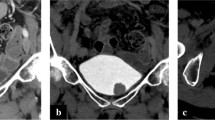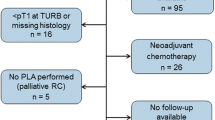Abstract
Objectives
To assess the power of multi-detector row computerized tomography (MDCT) in daily routine as a basic staging procedure for the decision on local treatment of patients with bladder cancer.
Patients and methods
We retrospectively analysed 276 patients who had undergone radical cystectomy between 2004 and 2008 and correlated the MDCT findings with pathological findings, number of removed lymph nodes and type of urinary diversion.
Results
Accuracy of MDCT in predicting pathological tumour stage was 49% (kappa coefficient, 0.23; P < 0.001). Overstaging occurred in 23.4%, and understaging occurred in 24.7%. Accuracy in predicting lymph node metastases was 54% (kappa coefficient, 0.04; P = 0.297). Overstaging and understaging occurred in 8.3 and 29.4%, respectively. Significantly more ileal conduits were performed in patients with high postoperative pathological tumour stages (P = 0.04) and positive lymph nodes (P = 0.013). In contrast, there was no correlation between preoperative CT tumour/nodal stage and the number of removed lymph nodes (P = 0.44 and P = 0.732, respectively), and between preoperative tumour stage and type of urinary diversion (P = 0.126).
Conclusions
MDCT as a preoperative staging procedure has a low accuracy in predicting the correct tumour and nodal stage, and therefore, it has little impact on decision-making for local treatment of muscle-invasive bladder cancer during radical cystectomy.
Similar content being viewed by others
References
Jemal A, Murray T, Ward E et al (2005) ) Cancer statistics, 2005. CA Cancer J Clin. 55:10–30
Stenzl A, Cowan NC, De Santis M et al (2011) Treatment of muscle-invasive and metastatic bladder cancer: update of the EAU guidelines. Eur Urol 59:1009–1018
Abol-Enein H, Tilki D, Mosbah A et al (2011) Does the extent of lymphadenectomy in radical cystectomy for bladder cancer influence disease-free survival? A prospective single-center study. Eur Urol
Karl A, Carroll PR, Gschwend JE et al (2009) The impact of lymphadenectomy and lymph node metastasis on the outcomes of radical cystectomy for bladder cancer. Eur Urol 55:826–835
Herr HW, Donat SM (2001) Outcome of patients with grossly node positive bladder cancer after pelvic lymph node dissection and radical cystectomy. J Urol 165:62–64; discussion 64
Katkoori D, Manoharan M, Araki M, Soloway MS (2010) Role of patient-physician dialogue in selecting the type of urinary diversion. Urol Int 84:40–44
Cho KS, Seo JW, Park SJ et al (2009) The risk factor for urethral recurrence after radical cystectomy in patients with transitional cell carcinoma of the bladder. Urol Int 82:306–311
Kuczyk M, Turkeri L, Hammerer P, Ravery V (2003) Is there a role for bladder preserving strategies in the treatment of muscle-invasive bladder cancer? Eur Urol 44:57–64
Sabaa MA, El-Gamal OM, Abo-Elenen M, Khanam A (2010) Combined modality treatment with bladder preservation for muscle invasive bladder cancer. Urol Oncol 28:14–20
Zhang J, Gerst S, Lefkowitz RA, Bach A (2007) Imaging of bladder cancer. Radiol Clin North Am 45:183–205
Caterino M, Giunta S, Finocchi V et al (2001) Primary cancer of the urinary bladder: CT evaluation of the T parameter with different techniques. Abdom Imaging 26:433–438
Ficarra V, Dalpiaz O, Alrabi N, Novara G, Galfano A, Artibani W (2005) Correlation between clinical and pathological staging in a series of radical cystectomies for bladder carcinoma. BJU Int 95:786–790
Paik ML, Scolieri MJ, Brown SL, Spirnak JP, Resnick MI (2000) Limitations of computerized tomography in staging invasive bladder cancer before radical cystectomy. J Urol 163:1693–1696
MacVicar AD (2000) Bladder cancer staging. BJU Int 86 Suppl 1:111–122
Baltaci S, Resorlu B, Yagci C, Turkolmez K, Gogus C, Beduk Y (2008) Computerized tomography for detecting perivesical infiltration and lymph node metastasis in invasive bladder carcinoma. Urol Int 81:399–402
Altman D, Douglas G (1991) Practical statistics for medical research. Chapman & Hall, London, p 404
Kim JK, Park SY, Ahn HJ, Kim CS, Cho KS (2004) Bladder cancer: analysis of multi-detector row helical CT enhancement pattern and accuracy in tumor detection and perivesical staging. Radiology 231:725–731
Fleischmann A, Thalmann GN, Markwalder R, Studer UE (2005) Extracapsular extension of pelvic lymph node metastases from urothelial carcinoma of the bladder is an independent prognostic factor. J Clin Oncol 23:2358–2365
Herr HW (1996) Routine CT scan in cystectomy patients: does it change management? Urology 47:324–325
Powles T, Murray I, Brock C, Oliver T, Avril N (2007) Molecular positron emission tomography and PET/CT imaging in urological malignancies. Eur Urol 51:1511–1520; discussion 1520–1521
Sherif A, Garske U, de la Torre M, Thorn M (2006) Hybrid SPECT-CT: an additional technique for sentinel node detection of patients with invasive bladder cancer. Eur Urol 50:83–91
Conflict of interest
The authors declare that they have no conflict of interest.
Author information
Authors and Affiliations
Corresponding author
Rights and permissions
About this article
Cite this article
Tritschler, S., Mosler, C., Straub, J. et al. Staging of muscle-invasive bladder cancer: can computerized tomography help us to decide on local treatment?. World J Urol 30, 827–831 (2012). https://doi.org/10.1007/s00345-011-0817-6
Received:
Accepted:
Published:
Issue Date:
DOI: https://doi.org/10.1007/s00345-011-0817-6




